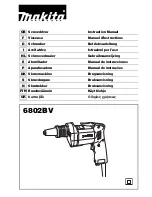
8
For tool with deep bit hole
011405
1. To install the bit, pull the sleeve in the direction of the
arrow and insert the bit into the sleeve as far as it will
go. Then release the sleeve to secure the bit.
(Fig. 10)
2. To install the bit, pull the sleeve in the direction of the
arrow and insert the bit-piece and bit into the sleeve
as far as it will go. The bit-piece should be inserted
into the sleeve with its pointed end facing in. Then
release the sleeve to secure the bit.
(Fig. 11)
To remove the bit, pull the sleeve in the direction of the
arrow and pull the bit out firmly.
NOTE:
• If the bit is not inserted deep enough into the sleeve,
the sleeve will not return to its original position and the
bit will not be secured. In this case, try re-inserting the
bit according to the instructions above.
OPERATION
Screwdriving operation (Fig. 12)
Place the point of the driver bit in the screw head and
apply pressure to the tool. Then switch the tool on. When
the clutch cuts in, the motor will stop automatically. Then
release the switch trigger.
NOTE:
• Make sure that the driver bit is inserted straight in the
screw head, or the screw and/or bit may be damaged.
Limits of fastening capacity
Use the tool within the range of the revolution angle up to
360°. If you use the tool beyond the upper limit of this
range, the clutch does not work. And the tool cannot
deliver enough fastening torque.
NOTE:
• The revolution angle means the angle which a screw/
bolt revolves when the tool attains to 100% from 50%
of desired torque.
• Use of a low temperature conditioned battery cartridge
may sometimes give warning for battery cartridge
capacity by warning lamp and beeper which makes the
tool stop immediately. In this case, the fastening
capacity may be inferior to the specification on this
manual even if a charged battery cartridge is used.
MAINTENANCE
CAUTION:
• Always be sure that the tool is switched off and the
battery cartridge is removed before attempting to
perform inspection or maintenance.
• Never use gasoline, benzine, thinner, alcohol or the
like. Discoloration, deformation or cracks may result.
Replacing carbon brushes (Fig. 13)
Remove and check the carbon brushes regularly. Replace
when they wear down to the limit mark. Keep the carbon
brushes clean and free to slip in the holders. Both carbon
brushes should be replaced at the same time. Use only
identical carbon brushes.
Use a screwdriver to remove the brush holder caps. Take
out the worn carbon brushes, insert the new ones and
secure the brush holder caps.
(Fig. 14)
To maintain product SAFETY and RELIABILITY, repairs,
any other maintenance or adjustment should be
performed by Makita Authorized Service Centers, always
using Makita replacement parts.
OPTIONAL ACCESSORIES
CAUTION:
• These accessories or attachments are recommended
for use with your Makita tool specified in this manual.
The use of any other accessories or attachments might
present a risk of injury to persons. Only use accessory
or attachment for its stated purpose.
If you need any assistance for more details regarding
these accessories, ask your local Makita Service Center.
• Makita genuine battery and charger
• Adjust grip
• Protector
• Anti kickback attachment
NOTE:
• Some items in the list may be included in the tool
package as standard accessories. They may differ
from country to country.
Noise
ENG905-1
The typical A-weighted noise level determined according
to EN62841-2-2:
Sound pressure level (L
pA
): 70 dB (A) or less
Uncertainty (K): 3 dB (A)
The noise level under working may exceed 80 dB (A)
ENG907-1
• The declared noise emission value(s) has been
measured in accordance with a standard test method
and may be used for comparing one tool with another.
• The declared noise emission value(s) may also be
used in a preliminary assessment of exposure.
WARNING:
• Wear ear protection.
• The noise emission during actual use of the power
tool can differ from the declared value(s)
depending on the ways in which the tool is used
especially what kind of workpiece is processed.
• Be sure to identify safety measures to protect the
operator that are based on an estimation of
exposure in the actual conditions of use (taking
account of all parts of the operating cycle such as
the times when the tool is switched off and when it
is running idle in addition to the trigger time).
A=17 mm
B=14 mm
To install these types of bits, follow the
procedure (1).
A=12 mm
B=9 mm
To install these types of bits, follow
the procedure (2).
(Note) Bit-piece is necessary for installing
the bit.
Summary of Contents for DFT043F
Page 3: ...3 9 004521 10 004047 11 011415 12 011392 13 001145 14 004250 17 18 19 20 21 22 ...
Page 58: ...58 ...
Page 59: ...59 ...









































